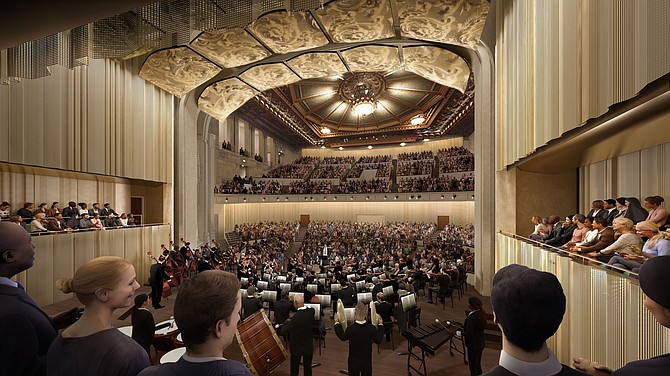 Facebook
Facebook
 X
X
 Instagram
Instagram
 TikTok
TikTok
 Youtube
Youtube

Martha Gilmer, CEO of the San Diego Symphony, has announced a major project to restore and renovate its historic home, the Jacobs Music Center.
The project, with an estimated cost of $125 million, will honor the history of the Jacobs Music Center’s building, which opened in 1929 as a legendary Fox Theater, while enhancing the musical and performance experience for artists and audiences.
The revitalization of Jacobs Music Center will include the transformation of Copley Symphony Hall, including the reconfiguration of the stage; the addition of a choral terrace behind the orchestra, which will allow for performances of large orchestral programs featuring chorus or as a new audience seating option; new finishes and seating; state-of-the-art lighting, sound, and video equipment; and better acoustics for performers and audiences. The project will include the modernization and expansion of support spaces for musicians and the enhancement of audience amenities throughout Jacobs Music Center.
There’s a lot to unpack here and a few items do stand out. New finishes and seating is huge. The seats at The Jacobs Music Center aren’t uncomfortable, yet neither are they comfortable. I recall taking my seat at Segerstrom Hall, in Orange County, and realizing that it was comfortable.
I had no idea it was possible to be comfortable at a symphonic concert until that point. I can hope the new seating at The Jacobs Music Center is as accommodating.
The addition of a choral terrace is a big deal. For starters, it should mean more performances of large-scale choral music. More exciting than that is the opportunity to sit behind the orchestra facing the conductor. This would be my seating preference every time it was available.
Superior acoustics are always welcome in a symphonic venue. If the acoustics of a hall are good, it makes a huge difference. Hearing the Royal Concertgebouw on tour is one thing, hearing them in the Concertgebouw Hall is something different. The hall is part of the performance.
The acoustics at The Jacobs Music Center are fine, but they are not special.
The devices which will be primarily responsible for improving the acoustics are a custom-designed permanent orchestra enclosure and a tunable acoustic canopy that’s a collaboration of theatrical, acoustic, and architectural design. We must keep in mind that the proscenium at The Jacobs Music Center was designed for a movie theater and not an orchestra. The idea of a turnable acoustic canopy is fascinating. Science...


Martha Gilmer, CEO of the San Diego Symphony, has announced a major project to restore and renovate its historic home, the Jacobs Music Center.
The project, with an estimated cost of $125 million, will honor the history of the Jacobs Music Center’s building, which opened in 1929 as a legendary Fox Theater, while enhancing the musical and performance experience for artists and audiences.
The revitalization of Jacobs Music Center will include the transformation of Copley Symphony Hall, including the reconfiguration of the stage; the addition of a choral terrace behind the orchestra, which will allow for performances of large orchestral programs featuring chorus or as a new audience seating option; new finishes and seating; state-of-the-art lighting, sound, and video equipment; and better acoustics for performers and audiences. The project will include the modernization and expansion of support spaces for musicians and the enhancement of audience amenities throughout Jacobs Music Center.
There’s a lot to unpack here and a few items do stand out. New finishes and seating is huge. The seats at The Jacobs Music Center aren’t uncomfortable, yet neither are they comfortable. I recall taking my seat at Segerstrom Hall, in Orange County, and realizing that it was comfortable.
I had no idea it was possible to be comfortable at a symphonic concert until that point. I can hope the new seating at The Jacobs Music Center is as accommodating.
The addition of a choral terrace is a big deal. For starters, it should mean more performances of large-scale choral music. More exciting than that is the opportunity to sit behind the orchestra facing the conductor. This would be my seating preference every time it was available.
Superior acoustics are always welcome in a symphonic venue. If the acoustics of a hall are good, it makes a huge difference. Hearing the Royal Concertgebouw on tour is one thing, hearing them in the Concertgebouw Hall is something different. The hall is part of the performance.
The acoustics at The Jacobs Music Center are fine, but they are not special.
The devices which will be primarily responsible for improving the acoustics are a custom-designed permanent orchestra enclosure and a tunable acoustic canopy that’s a collaboration of theatrical, acoustic, and architectural design. We must keep in mind that the proscenium at The Jacobs Music Center was designed for a movie theater and not an orchestra. The idea of a turnable acoustic canopy is fascinating. Science...
Comments